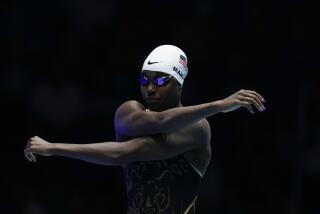Plunging In
- Share via
Beckoned by her swimming instructor, Surbhi Shah stretched out on her stomach and started to float, only to get so nervous she scrambled back to the side.
“I always feel like I’m going to lose control,” the 52-year-old Northridge woman said on the first day of her swimming class at the North Valley Family YMCA in Porter Ranch. “I have a fear of water, that’s why I’m doing this. I’d like to not have that fear.”
A few minutes later, Shah made a breakthrough, by sitting on two foam tubes. “I can float on my own!” she exclaimed, giving a high five to instructor Isabel Anisimov.
At a time of year when countless parents are shuttling children to swim lessons, many adults are struggling to pick up skills they didn’t learn in childhood. Ask nearly any adult taking swim lessons and they will say they wish they had learned as a child, but for many, especially immigrants, swimming pools were either nonexistent or essentially reserved for the elite.
“They have [health] clubs in India, but there was always a problem with distance or cost or all the spaces were taken up by life memberships,” said Shah, who emigrated in 1975. “I have more time now, that’s why I’m catching up, doing things I didn’t do as a child.”
Fellow student Rao Aysola also grew up in India, but did some swimming as a child--in a deep well, with bamboo reeds strapped to his back as makeshift life jacket. Despite his experience, he is hesitant in the pool.
“I have to get my courage up to put my face in the water,” said Aysola, 60, as the class was starting.
Soon after, Anisimov had her beginner students stand in the 4-foot section of the indoor pool to practice arm strokes. They took turns attempting to float and swim to her, often with trepidation.
To ease their fears, Anisimov said, “You can stand up, so don’t be scared. It’s not deep water.” Then she swam to the middle of the huge pool and said, “See? I’m standing.”
Aside from immigrants like Anisimov’s student Almas Allaudin, 50, from Pakistan, who had little or no access to swimming pools, an increasing number of American-born adults don’t know how to swim, in part because high schools have dropped or curtailed their swimming programs.
“In the 1950s and ‘60s, swimming was part of the P.E. curriculum. It was a requirement to swim to graduate,” said Laura Slane, national aquatics director for the YMCA of the USA, headquartered in Chicago. “Because it’s been de-emphasized, you have a lot fewer adults now who know how to swim.”
Teaching adults to swim is different from teaching youngsters, who may not understand the realities of drowning and don’t come to the pool with mental baggage, swim instructors said. Some adults may have been forced to take swim lessons as children, or, even worse, thrown into the deep end of the pool, experiences that create deep-seated anxieties.
Norberto Montalban, aquatics director at the YMCA of Glendale, even had a student whose mother used to punish him by holding his face under water in the bathtub.
“Many of them always wanted to learn to swim, but they’re afraid of the water. Many have had a bad experience and throughout the years, it’s created a lot of fear. When they go under the water, it brings back a lot of memories,” said Montalban, who estimates that 75% of his adult students become water safe after a month of lessons.
Because Montalban learned to swim when he was 17, he finds it’s easier to teach adults.
“I can relate to their fear because I had the same problem,” he said. “The water is something you don’t have control over. In the back of their mind, they have a fear of drowning.”
When teaching older people, Montalban said he talks about the principals of gravity, which dictate that a person’s center of gravity changes when they bring their head out of the water. He also demonstrates that if you take a deep breath, your lungs will help you float.
“I take them to the deep end and show them it’s simple. They will still float. They think they’re going to drown,” he said.
The fear that her children could drown if she did not swim motivated Esther Hur to take lessons at the North Valley Jewish Community Center. When the Northridge resident enrolled her 5-year-old daughter at the center’s Kids Aquatic Swim School, she also signed up for lessons.
She said she learned to float on her back in 15 minutes.
“One of the reasons I’m learning as quickly as I am is I want to be able to save [my children] if they fall in. I have to know [how to swim] if something happens,” said Hur, 33, who also has a 2-year-old son.
Floating on her back has opened up a new world for Hur, who has been afraid of the water all her life. She used to be so frightened that watching movies like “The Hunt for Red October” would make her tense.
Now, she said she “swims a little bit,” and if her instructor asked her to jump in the pool, she thinks she could. “It was such an amazing feeling,” she said. “I’m hooked.”
More to Read
Sign up for Essential California
The most important California stories and recommendations in your inbox every morning.
You may occasionally receive promotional content from the Los Angeles Times.













